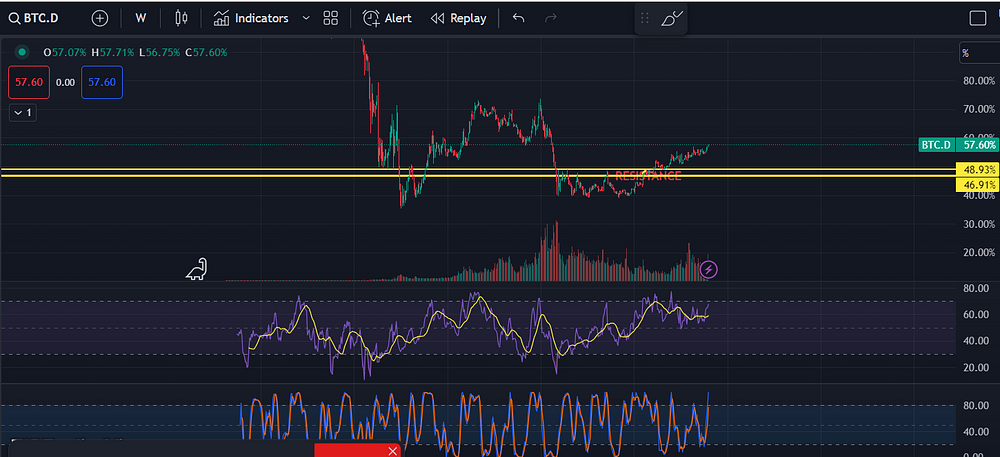- Digital Vault
- Posts
- How I Use Bitcoin's Dominance In My Portfolio
How I Use Bitcoin's Dominance In My Portfolio
What It Means For You
As someone who’s been closely following the crypto markets for years, I’ve seen trends come and go, but one thing that’s become increasingly clear in 2024 is the undeniable rise of Bitcoin’s dominance. Since November 2022, Bitcoin’s share of the total cryptocurrency market capitalization has been on a steady upward trajectory. As we move deeper into the second half of 2024, Bitcoin’s dominance is on track to hit 60% by year-end. But what does this mean for the broader crypto market? Let’s dive in.

The Steady Rise of Bitcoin’s Dominance
Bitcoin’s dominance is a metric that measures the percentage of the total cryptocurrency market cap that Bitcoin represents. For much of crypto history, Bitcoin has been the undisputed leader, but as the market matured, altcoins began to capture a significant share of the pie. However, the current trend shows that Bitcoin is reclaiming its position as the king of crypto, and there are several reasons for this shift.
The macroeconomic landscape has been a significant factor. With global financial markets facing unprecedented uncertainty, many investors are turning to Bitcoin as a “safe haven” asset. The narrative that Bitcoin is “digital gold” has never been stronger, especially with figures like Michael Saylor, the CEO of MicroStrategy, famously stating, “There’s no second best.” This growing confidence in Bitcoin’s long-term value proposition is driving more capital into BTC, at the expense of altcoins.
Another key factor is the increasing institutional interest in Bitcoin. The approval of spot Bitcoin ETFs in the U.S. has been a game-changer. These ETFs have attracted over $17.5 billion in inflows, showcasing the growing demand from institutional investors. This influx of mature capital is stabilizing Bitcoin prices, making it a more attractive investment for those looking to avoid the volatility often associated with altcoins.
Bitcoin and Ethereum: The Big Leagues
While Bitcoin is the primary beneficiary of this trend, Ethereum is also playing a significant role. Both Bitcoin and Ethereum are beginning to decouple from the broader altcoin market, indicating their maturity as assets. This decoupling is evident in their performance compared to traditional financial assets. For instance, as of July 27th, Nvidia and Bitcoin have outperformed common TradFi investments, signaling a shift where major cryptos are seen as safer bets.
This decoupling suggests that Bitcoin and Ethereum are evolving into a new asset class altogether — one that is more resilient to market fluctuations and less correlated with the riskier, speculative altcoin market. Investors are recognizing that these two assets offer something that most altcoins do not: a proven track record, institutional backing, and a level of security that has withstood the test of time.
The Impact on Altcoins
As Bitcoin’s dominance continues to rise, the altcoin market is facing increasing pressure. Altcoins, which once promised higher returns, are now seen as riskier bets in a market environment that is becoming more risk-averse. This shift is reflected in the declining market share of many altcoins, some of which are struggling to maintain relevance as investors flock to Bitcoin and Ethereum.
However, this doesn’t mean that all altcoins are doomed. We’re likely to see a consolidation in the altcoin market, where only the projects with the strongest fundamentals, most innovative technology, and real-world utility will survive. The era of speculative investing in any new coin that promises quick returns is fading, replaced by a more discerning investor base that prioritizes long-term potential over short-term gains.
What This Means for the Future
So, what does all this mean for the future of the crypto market? If Bitcoin’s dominance continues to grow, we could be looking at a market that is more stable, less volatile, and increasingly recognized as a legitimate asset class by the broader financial world. This could lead to further integration of Bitcoin and Ethereum into traditional financial systems, with more products like ETFs, mutual funds, and even Bitcoin-backed loans becoming commonplace.
For investors, this trend suggests a shift in strategy. While the allure of high-risk, high-reward altcoins may still appeal to some, the growing dominance of Bitcoin and Ethereum points to the importance of having a solid allocation in these two assets as part of a diversified crypto portfolio. The days of betting it all on the next “moonshot” altcoin may be coming to an end.
As we approach the end of 2024, it will be fascinating to see how this trend develops. Will Bitcoin’s dominance continue to rise, or will we see a resurgence in altcoins? One thing is certain: the crypto market is evolving, and those who adapt to these changes will be the ones who thrive in the years to come.
In conclusion, Bitcoin’s growing dominance is not just a reflection of its strength as an asset but also a sign of the crypto market’s maturation. As investors, it’s crucial to stay informed, adapt to these shifts, and recognize the long-term potential of the assets that are leading the charge. Bitcoin is back on top, and it looks like it’s here to stay.
Your next step
Stay tuned to my next issue, where I will continue to give my insights on crypto + entrepreneurship to financial freedom!
Follow me on twitter (@healthy_we44554) and threads (@wise.healthy.wealth)